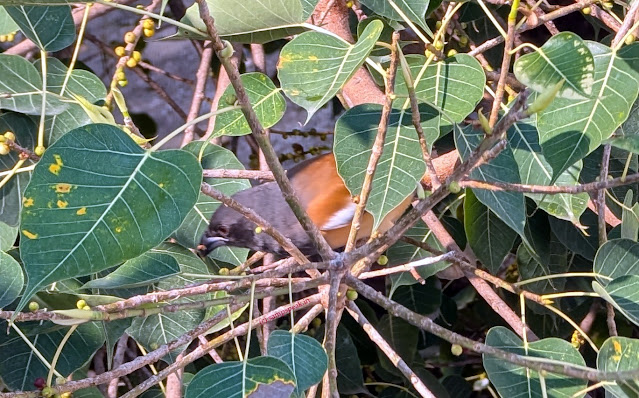Ficus religiosa or sacred fig is a species of fig
native to the Indian subcontinent and Indochina that belongs to Moraceae, the fig or mulberry
family. It is also known as the bodhi tree, Peepal tree, ashvattha tree [அரச மரம்]. The sacred fig is
considered to have a religious significance in four major religions that
originated on the Indian subcontinent: Hinduism, Buddhism, Sikhism and Jainism.
Hindu and Jain ascetics consider the species to be sacred and often meditate
under it. Gautama Buddha attained enlightenment – do you see anything in this Arasa maram ??
Kuyil, Koel, Cuckoo – is a songbird – when heard – the sound may not exactly attract you! .. common perception is the
Cuckoo (Cuculus canorus) is jet black in colour resembling a Crow but
having red eyes ! .. .. some
Cuckoos have a grey head with a thin, bright yellow ring around their eye,
yellow feet and a black beak. They have dark grey plumage on their upper parts
and barred plumage below which resembles the markings of the sparrowhawk. Some
females are a rusty-brown colour.
மஹாகவி சுப்ரமண்ய பாரதியாரின் குயில்பாட்டு, (the songbird Cuckoo) மற்றைப்
பாட்டுகளினின்றும் வேறுபாடானது. கவிஞன், குயிலொடு கொண்ட காதலைத் தானே சொல்வதாக அமைகிறது.
விழுமிய பொருளையும் உயர்ந்த தத்துவக் கருத்தையும் மனித வாழ்க்கையை, லட்சியத் துணையோடு
இணைக்கும் வகையிலும் அமைந்து, பொருள்நயமும், கவிதை இனிமையும் சேர்ந்த இத்தொகுப்பு பாரதியார்
பாண்டிச்சேரியில் வாழ்ந்தபோது இயற்றப்பட்டதாம்.
காலைத் துயிலெழுந்து,காலிரண்டு முன்போலே
சோலைக்கிழுத்திட,நான் சொந்த உணர்வில்லாமே
சோலையினில் வந்து நின்று,சுற்றுமுற்றுந்
தேடினேன்,
கோலப் பறவைகளின் கூட்டமெல்லாங் காணவில்லை.
மூலையிலோர் மாமரத்தின் மோட்டுக் கிளையினிலே
நீலக் குயிலிருந்து நீண்டகதை சொல்லுவதும் !! ,...
புதுச்சேரியில் கடல் அலை எழுப்பும் ஓசை கவிஞருக்கு வேதப் பொருளை உரைத்ததாம்; கடல் அலைகள் மட்டுமல்ல ~ குக்கு குக்கூவென்று குயில் பாடும் பாட்டில் தொக்க பொருளெல்லாம் தோன்றுகின்றது அவரது சிந்தைக்கே.
Cuckoo, (குயில்) of the family
Cuculidae, designates some 60 arboreal
members of the subfamilies Cuculinae and Phaenicophaeinae. Cuculids range in
length from about 16 cm (6.5 inches) in the glossy cuckoos (Chrysococcyx and
Chalcites) to about 90 cm (36 inches) in the larger ground cuckoo. Koels have long, graduated tails, usually
with the individual feathers tipped with white. The bill is rather stout and
somewhat downcurved.
This morning inside the dense Peepal leaves saw a multi-coloured
bird, later realized it resembled a dove but perhaps is a Cuckoo. A brown Cuckoo !!!
The brown cuckoo-dove (Macropygia phasianella) is a dove in the genus Macropygia found in Australia from Weipa and Aurukun in the north to Bega in the south, and most inland at Atherton and Toowoomba. It is sometimes called the "brown pigeon" or "pheasant pigeon". The brown cuckoo-dove was formally described in 1821 by the Dutch zoologist Coenraad Jacob Temminck from a specimen collected near Port Jackson in New South Wales, Australia. He coined the binomial name Columba phasianella. The specific name is a diminutive of the Latin phasianus, meaning "pheasant". The brown cuckoo-dove is now placed in the genus Macropygia, which was introduced by the English naturalist William John Swainson in 1837.
The feathers of brown cuckoo are a rich rusty-brown colour, and the short wings, long tail and back are darker. The males tend to have a slight rose/green colouration on their nape and neck. The call of this dove is a very loud "whoop-a whoop" with some differences depending on the subspecies involved.
Hoping that this beauty
would give another appearance and present itself to be photographed closer !!
With regards – S Sampathkumar
7.10.2024
.jpg)

.jpg)

No comments:
Post a Comment